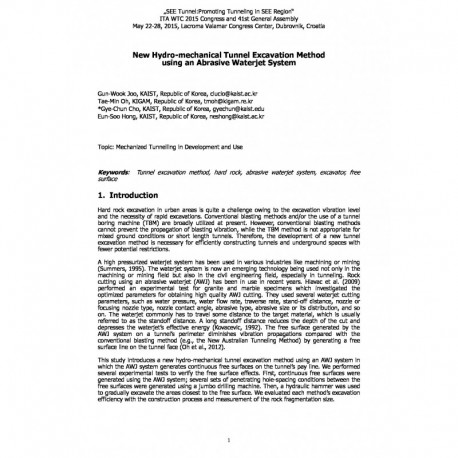Cart
0
0
No document
0,00 €
Total
Document successfully added to your shopping cart
Quantity
Total
There are 0 items in your cart.
There is 1 item in your cart.
Total documents
Total shipping
To be determined
Total
Search & filter
Search for a publication
Search & filter

New Hydro-mechanical Tunnel Excavation Method using an Abrasive Waterjet System
wtc2015_fullpaper_jgw_150126-2
G. C. Cho / T. M. Oh / G. W. Joo / E. S. Hong
Hard rock excavation in urban areas is quite a challenge owing to the excavation vibration level and the necessity of rapid excavations. Conventional blasting methods and/or the use of a tunnel boring machine (TBM) are broadly utilized at present. However, conventional blasting methods cannot prevent the propagation of blasting vibration, while the TBM method is not appropriate for mixed ground conditions or short length tunnels. Therefore, the development of a new tunnel excavation method is necessary for efficiently constructing tunnels and underground spaces with fewer potential restrictions. A high pressurized waterjet system has been used in various industries like machining or mining (Summers, 1995). The waterjet system is now an emerging technology being used not only in the machining or mining field but also in the civil engineering field, especially in tunneling. Rock cutting using an abrasive waterjet (AWJ) has been in use in recent years. Hlavac et al. (2009) performed an experimental test for granite and marble specimens which investigated the optimized parameters for obtaining high quality AWJ cutting. They used several waterjet cutting parameters, such as water pressure, water flow rate, traverse rate, stand-off distance, nozzle or focusing nozzle type, nozzle contact angle, abrasive type, abrasive size or its distribution, and so on. The waterjet commonly has to travel some distance to the target material, which is usually referred to as the standoff distance. A long standoff distance reduces the depth of the cut and depresses the waterjet’s effective energy (Kovacevic, 1992). The free surface generated by the AWJ system on a tunnel’s perimeter diminishes vibration propagations compared with the conventional blasting method (e.g., the New Australian Tunneling Method) by generating a free surface line on the tunnel face (Oh et al., 2012). This study introduces a new hydro-mechanical tunnel excavation method using an AWJ system in which the AWJ system generates continuous free surfaces on the tunnel’s pay line. We performed several experimental tests to verify the free surface effects. First, continuous free surfaces were generated using the AWJ system; several sets of penetrating hole-spacing conditions between the free surfaces were generated using a jumbo drilling machine. Then, a hydraulic hammer was used to gradually excavate the areas closest to the free surface. We evaluated each method’s excavation efficiency with the construction process and measurement of the rock fragmentation size.



